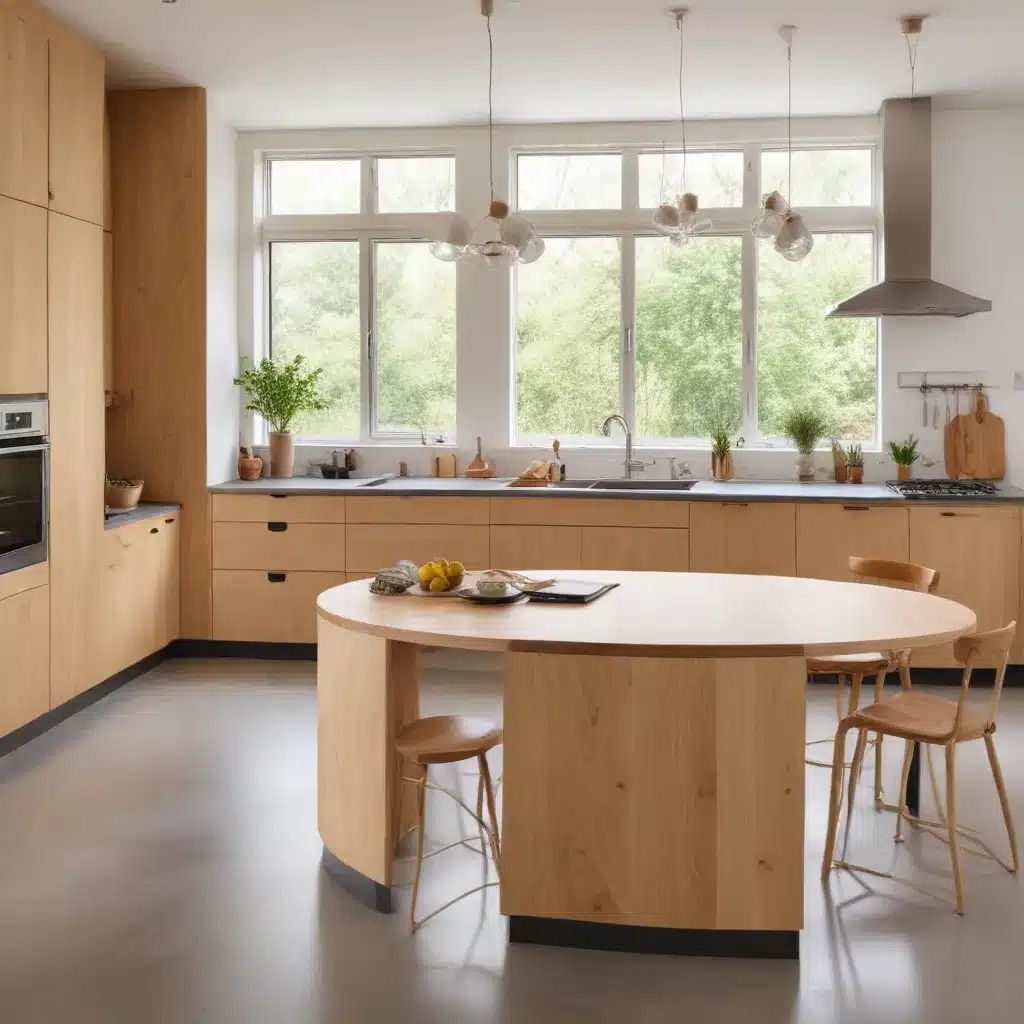
Sustainable Kitchen Design: Reducing Waste Through Circular Thinking
As an experienced home improvement consultant, I’ve seen firsthand how the kitchen is often the heart of the home – a place where families gather, meals are prepared, and memories are made. However, in our modern, fast-paced world, kitchens can also be a significant source of waste, from single-use plastics to spoiled food. That’s why sustainable kitchen design is becoming an increasingly important consideration for homeowners and designers alike.
At the core of sustainable kitchen design is the principle of circular thinking – a mindset that aims to eliminate waste and maximize the use of resources. Rather than the traditional linear “take-make-waste” approach, circular thinking promotes closed-loop cycles where materials are continuously reused, repurposed, or recycled.
Principles of Circular Thinking
Closed-Loop Cycles: The goal is to design kitchens that function in a closed loop, where materials and resources are continuously cycled back into the system instead of ending up in landfills. This might involve using recyclable or compostable materials, implementing take-back programs for old appliances, or developing innovative ways to repurpose waste.
Waste Minimization: Sustainable kitchen design also focuses on minimizing waste at every stage, from the manufacturing and installation processes to the daily use of the space. This can include sourcing low-waste or zero-waste materials, implementing efficient storage solutions to reduce food waste, and educating homeowners on waste-reducing habits.
Resource Efficiency: Efficiency is a key tenet of circular thinking, whether it’s optimizing energy and water usage, maximizing the lifespan of materials, or finding ways to extract the maximum value from each resource. This could involve specifying energy-efficient appliances, incorporating water-saving fixtures, or designing modular cabinetry that can be easily reconfigured or repaired.
Materials and Resources
Sustainable kitchen design starts with the materials and resources used in the space. Homeowners and designers should prioritize sustainable materials that are renewable, recyclable, or upcycled.
Sustainable Materials: Look for options like bamboo for cabinetry, recycled glass or quartz for countertops, and wood-fiber or cork flooring. These materials not only reduce environmental impact but can also add unique, natural charm to the kitchen.
Renewable Resources: Incorporating renewable resources, such as solar energy or geothermal heating, can further enhance the sustainability of a kitchen design. These systems not only reduce energy consumption but also lower utility bills and minimize the home’s carbon footprint.
Upcycling Opportunities: Get creative with upcycling – repurposing existing materials or furnishings in new and innovative ways. This could involve transforming an old dresser into a kitchen island, using reclaimed wood for shelving, or repurposing vintage glass jars as storage containers.
Eco-Friendly Kitchen Appliances
The kitchen is a hub of energy and water usage, making the selection of energy-efficient appliances and water-conserving fixtures a crucial aspect of sustainable design.
Energy-Efficient Appliances
Reducing Energy Consumption: When choosing new kitchen appliances, look for Energy Star-certified models that use significantly less energy than their traditional counterparts. Features like induction cooktops, convection ovens, and efficient dishwashers can make a real difference in energy savings.
Renewable Energy Integration: Take the sustainability of your kitchen to the next level by incorporating renewable energy sources, such as solar panels or heat pump water heaters. These systems can help offset the energy consumption of your appliances and reduce your reliance on fossil fuels.
Water Conservation Strategies
Water-Saving Fixtures: Installing low-flow faucets, water-efficient dishwashers, and high-performance showerheads can dramatically reduce water usage in the kitchen. These fixtures are designed to deliver the same performance with significantly less water consumption.
Greywater Recycling: Consider implementing a greywater recycling system that collects and treats used water from sinks, showers, and washing machines for reuse in applications like toilet flushing or landscape irrigation. This can be an impactful way to conserve freshwater resources.
Innovative Storage Solutions
Sustainable kitchen design also focuses on maximizing efficiency and minimizing waste through innovative storage solutions.
Space-Saving Design
Modular Cabinetry: Modular cabinetry systems allow for flexible and customizable storage, making the most of available space. These modular units can be rearranged, expanded, or even repurposed as needs change, reducing the need for complete kitchen renovations.
Multifunctional Elements: Incorporating multifunctional design elements, such as a pull-out spice rack or a hidden recycling center, can help streamline the kitchen and minimize clutter.
Minimizing Food Waste
Smart Refrigeration: Investing in a smart refrigerator with features like humidity control, automatic temperature adjustment, and food storage monitoring can help reduce food spoilage and waste.
Composting Systems: Integrating a composting system into the kitchen design, whether a countertop bin or an in-sink disposal, allows homeowners to divert organic waste from landfills and turn it into nutrient-rich soil for their gardens.
Sustainable Lifestyle Integration
Sustainable kitchen design goes beyond the physical space – it also encompasses the homeowner’s habits and the broader community engagement.
Culinary Education
Cooking for Sustainability: Providing culinary education and cooking workshops for homeowners can empower them to adopt more sustainable cooking practices, such as meal planning, food preservation techniques, and recipe optimization to reduce waste.
Food Preservation Methods: Educating homeowners on food preservation methods, like canning, dehydrating, and freezing, can help extend the lifespan of fresh produce and minimize food waste.
Community Engagement
Shared Resources: Encouraging community-level initiatives, such as neighborhood tool libraries or shared appliance programs, can foster a culture of resource sharing and reduce individual ownership of underutilized items.
Neighborhood Initiatives: Collaborating with local organizations to organize food swaps, community gardens, or composting programs can create a sense of shared responsibility and promote sustainable practices throughout the community.
By embracing the principles of circular thinking, sustainable kitchen design can not only reduce waste and environmental impact but also foster a more mindful, connected, and resilient lifestyle. As an experienced home improvement consultant, I encourage homeowners and designers to explore these strategies and integrate them into their upcoming kitchen projects. Visit https://www.reluctantrenovator.com for more inspiration and practical tips on sustainable home renovations.



